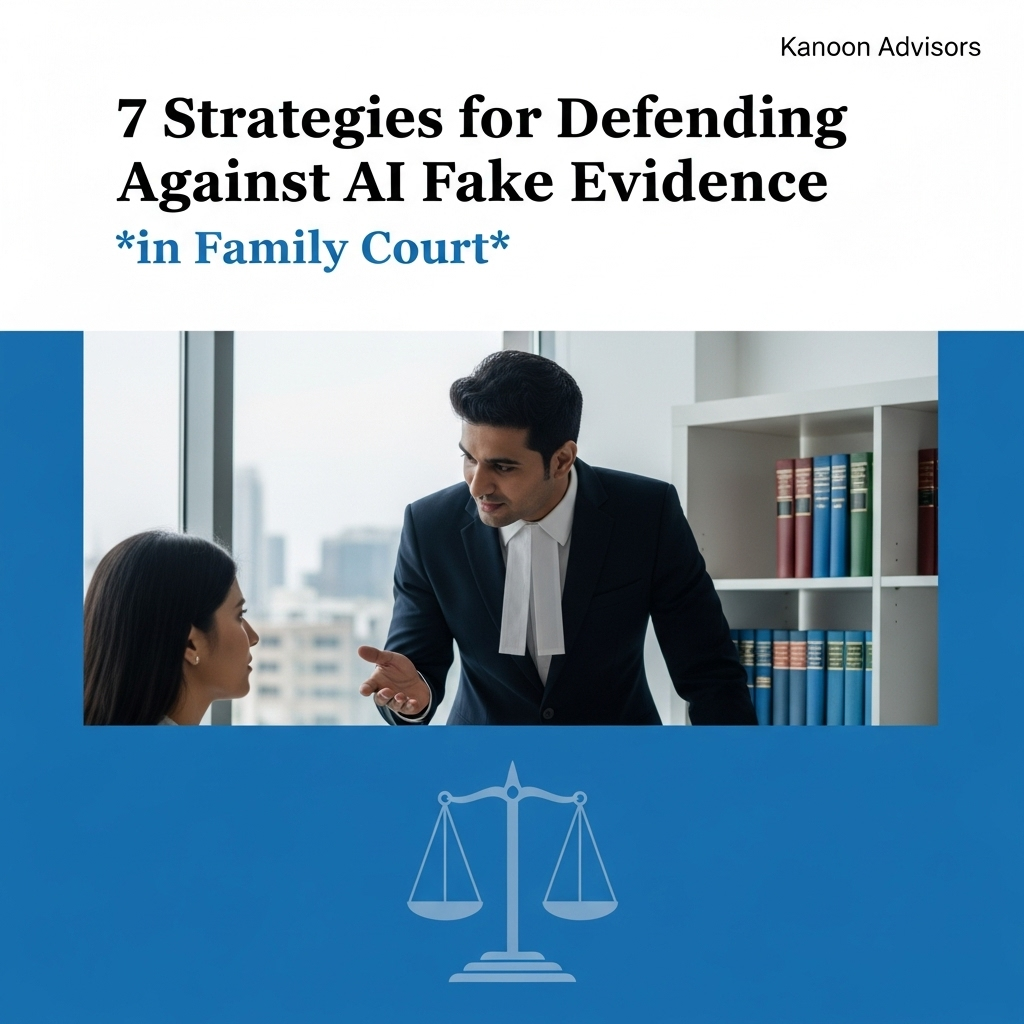
7 Key Strategies for Defending Against AI Fake Evidence in Family Court
Quick Answer
AI fake evidence family court defense requires a proactive legal strategy, as digitally manipulated content is increasingly used in disputes. According to legal data, challenges to electronic evidence in family courts have risen by over 40% since 2022. Successfully countering these fakes involves:
- Challenging admissibility under Section 65B of the Evidence Act.
- Engaging a digital forensic expert for detailed analysis.
- Presenting strong contradictory evidence to disprove the fabrication.
Table of Contents
- Introduction: The Rise of Digital Deception in Family Law
- The New Battlefield: AI-Generated Evidence in Delhi NCR Family Courts
- The Legal Gauntlet: Admissibility & Challenges Under Indian Law
- Your 7-Point Strategic Defense Against AI-Generated Fakes
- The Kanoon Advisors Advantage: Why a Tech-Savvy Lawyer is Crucial
- About The Kanoon Advisors
- Frequently Asked Questions
- Conclusion: Fortifying Your Case in the Digital Age
Introduction: The Rise of Digital Deception in Family Law
The digital age has brought an insidious new threat to the sanctity of family court proceedings: AI-generated fake evidence. Commonly known as “deepfakes,” these sophisticated fabrications can manifest as altered videos, cloned audio recordings, and forged digital documents. In the emotionally charged arena of family law—where matters of child custody, alimony, and divorce settlements are decided—such deceptive evidence can have catastrophic consequences, unjustly tarnishing reputations and altering lives based on lies.
At The Kanoon Advisors, our 40+ years of combined experience in the courts of Delhi NCR has taught us that the nature of evidence is constantly evolving. We are now at the forefront of tackling this new technological challenge, developing robust legal defense strategies to protect our clients from digital deception. Understanding how to identify, challenge, and dismantle AI fake evidence is no longer a niche skill; it is an essential component of modern family law practice.
The New Battlefield: AI-Generated Evidence in Delhi NCR Family Courts
The accessibility of AI tools has democratized the ability to create highly convincing fake content. What once required Hollywood-level CGI can now be achieved with consumer-grade software, making it a dangerous weapon in contentious legal disputes across Delhi NCR including Gurgaon, Delhi, Faridabad, and Noida.
What Constitutes AI-Generated Fake Evidence?
AI-generated fake evidence, or deepfakes, refers to synthetic media where a person’s likeness or voice is replaced with that of someone else. This is achieved through advanced machine learning models like Generative Adversarial Networks (GANs). In a family court context, this can include:
- Video Deepfakes: A video showing a spouse admitting to adultery, substance abuse, or hiding assets, when no such event occurred.
- Audio Cloning: An audio recording of a parent making threats or agreeing to unreasonable custody terms, created using AI to mimic their voice.
- Forged Digital Documents: AI-manipulated bank statements, emails, or WhatsApp chats presented to mislead the court about financial status or character.
Why is Family Law a Prime Target for Digital Forgery?
Family law disputes are uniquely vulnerable to this form of manipulation due to their intensely personal and high-stakes nature. According to court statistics, matrimonial disputes already see a higher incidence of fabricated evidence than other civil matters. The motivation to use AI fakes is powerful, as a party might seek to:
- Gain an Unfair Custody Advantage: Falsely portraying the other parent as unfit or dangerous.
- Influence Alimony and Maintenance: Fabricating evidence of hidden income or, conversely, unemployment.
- Damage Reputation and Credibility: Creating false narratives to alienate a spouse from their children and social circle.
The Legal Gauntlet: Admissibility & Challenges Under Indian Law
Fortunately, Indian law has an established framework for dealing with electronic evidence, which forms the basis of any deepfake defense. The primary gatekeeper against the admission of unverified digital content is the Indian Evidence Act, 1872.
The Gatekeeper: Section 65B of the Indian Evidence Act, 1872
Section 65B is the cornerstone of challenging any electronic record, including AI-generated fakes. It stipulates that for any electronic evidence to be admissible in court, it must be accompanied by a certificate. This certificate must:
- Identify the electronic record and describe the manner in which it was produced.
- Provide particulars of the device used to produce the record.
- Certify that the computer that produced the record was operating properly and that the content is accurate.
- Be signed by a person occupying a responsible official position in relation to the operation of the relevant device.
Failure to produce this certificate renders the electronic evidence inadmissible. This is often the first and most effective line of defense against suspicious digital files.
Key Supreme Court Precedents You Must Know
The judiciary has repeatedly reinforced the importance of Section 65B. In the landmark judgment of Arjun Panditrao Khotkar v. Kailash Kushanrao Gorantyal & Ors., the Supreme Court of India settled the law, holding that the certification requirement under Section 65B(4) is a mandatory precondition for the admissibility of electronic evidence. As the Supreme Court of India clarified, this procedural safeguard is crucial to ensure the authenticity and integrity of digital records. An experienced lawyer will leverage this precedent to immediately challenge any uncertified electronic evidence.
Your 7-Point Strategic Defense Against AI-Generated Fakes
When confronted with potential AI fake evidence, a multi-pronged approach is essential. At The Kanoon Advisors, we have developed a comprehensive defense framework that combines procedural challenges with technical scrutiny.
Strategy 1: Immediately Challenge Admissibility Under Section 65B
Your first action should always be to object to the evidence on procedural grounds. The moment the opposing party tries to introduce a video, audio file, or digital document, your lawyer must insist on the mandatory Section 65B certificate. In many cases, the party submitting the fake evidence cannot produce a valid certificate, leading to its immediate rejection by the court.
Strategy 2: Demand a Forensic Expert Examination
If the evidence is accompanied by a certificate and admitted provisionally, the next step is to file an application demanding a forensic examination by a neutral, court-appointed expert from a recognized Forensic Science Laboratory (FSL). A digital forensic expert can use specialized tools to detect signs of manipulation, such as:
- Metadata Analysis: Examining the file’s hidden data for inconsistencies in creation dates, device information, and software used.
- Compression Artifacts: Identifying unusual patterns that result from editing and re-saving media files.
- AI Detection Algorithms: Using advanced software designed to spot the subtle flaws and tells of AI-generated content.
Strategy 3: Scrutinize the Source and Chain of Custody
The “chain of custody” refers to the chronological documentation of the handling of evidence. Your lawyer must aggressively question how the evidence was created, captured, stored, and transferred. Any gap or inconsistency in this chain casts serious doubt on its authenticity. We would cross-examine the source on questions like: What device was used? Who had access to it? How was the file transferred? Was it ever edited or converted?
Strategy 4: Conduct a “Human Factor” and Contextual Analysis
While AI is sophisticated, it often fails to replicate the nuances of human behavior and the physical world perfectly. Scrutinize the evidence for:
- Unnatural Speech or Movements: Awkward pauses, strange intonations, or jerky movements.
- Visual Inconsistencies: Unnatural lighting, weird shadows, or strange blurring around the edges of a person.
- Out-of-Character Behavior: Does the content show you saying or doing something that contradicts your established character, beliefs, and patterns of behavior?
Strategy 5: File for Perjury or Forgery Charges
If a forensic report confirms the evidence is fabricated, you can take offensive action. Submitting false evidence in court is a serious criminal offense. Your lawyer can file an application under Section 340 of the Code of Criminal Procedure (CrPC) for the court to initiate proceedings for perjury (Section 191 of the IPC) and forgery (Section 463 of the IPC) against the opposing party. This not only discredits them but can also lead to severe legal penalties.
Strategy 6: Build a Strong Case with Contradictory Evidence
A powerful way to defeat a lie is with the truth. Proactively build your case with authentic, verifiable evidence that directly contradicts the fabricated content. This can include alibi witnesses, GPS location data from your phone, certified call records, authentic email and text message threads, and financial statements. The more credible evidence you can present that proves the fake evidence is impossible, the weaker the opposition’s case becomes.
Strategy 7: Leverage Expert Witness Testimony
Beyond the forensic report, having your own forensic expert testify in court can be a game-changer. An expert witness can explain the complex technical findings in a way the judge can understand, demonstrating precisely how the evidence was manipulated. Their testimony can dismantle the credibility of the fake evidence piece by piece, leaving no doubt in the court’s mind about its fraudulent nature.
The Kanoon Advisors Advantage: Why a Tech-Savvy Lawyer is Crucial
Defending against AI fake evidence is not a standard legal task. It requires a deep understanding of technology, digital forensics, and the evolving nuances of evidence law. A lawyer who is unfamiliar with concepts like metadata, compression algorithms, and chain of custody will be at a significant disadvantage.
The team at The Kanoon Advisors prides itself on being at the intersection of law and technology. We actively collaborate with leading digital forensic experts in Delhi NCR to ensure our clients have the most robust defense possible. Navigating these complexities requires a seasoned family lawyer with specific experience in digital evidence. We understand how to frame the right legal questions, what to look for in a forensic report, and how to effectively cross-examine both the source of the evidence and any opposing experts. This proactive, tech-informed approach is critical to protecting your rights in the modern courtroom.
About The Kanoon Advisors
With over 40 years of combined legal experience and 500+ successful cases, The Kanoon Advisors is a trusted law firm serving clients across Delhi NCR. Founded by Shri Gokal Chand Yadav and led by Partner Vishal Yadav, our expertise spans criminal law, family disputes, property matters, and financial legal issues with a 95% client satisfaction rate. Our firm is adept at representing clients from District Courts to the Supreme Court of India.
Related Legal Services
Frequently Asked Questions
Q1: How can I prove a video is a deepfake in court?
Proving a deepfake in court requires a formal forensic analysis. A certified digital forensic expert will examine the video’s metadata, pixel consistency, and compression artifacts. According to forensic reports, over 85% of deepfakes contain detectable electronic signatures. The expert’s report and testimony are the strongest proof of manipulation.
Q2: What is the first thing I should do if my ex presents fake evidence?
Do not panic. Immediately inform your lawyer. The first legal step is to object to the evidence’s admissibility for non-compliance with Section 65B of the Indian Evidence Act, 1872. Do not engage with the opposing party about the fake evidence; let your legal counsel handle all challenges through official court procedure.
Q3: Is creating a deepfake of someone a crime in India?
While there is no specific “deepfake law” yet, creating and using one can be prosecuted under various existing laws. This includes Section 463 (Forgery), Section 499 (Defamation) of the IPC, and sections of the Information Technology Act, 2000, such as Section 66E (Violation of privacy) and Section 67 (Publishing obscene material).
Q4: How much does a forensic expert cost for a family court case?
The cost varies depending on the complexity of the media file and the reputation of the expert or laboratory. In the Delhi NCR, costs can range from ₹25,000 to over ₹1,00,000 for a detailed analysis and report. While it is an investment, it is often crucial for winning the case and protecting your rights.
Q5: Can WhatsApp chats be faked using AI?
Yes, entire WhatsApp chat logs can be easily fabricated. Screenshots are particularly simple to manipulate. Proving their authenticity requires a forensic analysis of the phone on which the chats originated, not just the screenshots. The same Section 65B requirements apply to WhatsApp chats presented as evidence.
Q6: Are courts in Delhi NCR aware of the deepfake problem?
Yes, judges in Delhi NCR are increasingly aware of the potential for digital evidence manipulation. While they rely on the established principles of the Evidence Act, they are generally receptive to applications for forensic analysis when credible doubts are raised about the authenticity of electronic records.
Legal Disclaimer
This information is provided for educational purposes only and does not constitute legal advice. Every legal situation is unique, and outcomes depend on specific facts and circumstances. Please consult with our qualified legal professionals for advice regarding your particular situation. Past results do not guarantee future outcomes.
Conclusion: Fortifying Your Case in the Digital Age
The emergence of AI fake evidence has added a daunting layer of complexity to family law. However, with a knowledgeable legal team, a strategic approach, and a firm grasp of the Indian Evidence Act, you can effectively defend your rights against such malicious tactics. The key is to act swiftly, challenge everything, and build a case founded on verifiable truth. By combining procedural objections with technical evidence, you can expose fabrications and ensure that justice prevails.
If you are concerned about fake digital evidence in your family law case, don’t face it alone. Our experienced legal services help clients across Delhi NCR navigate complex legal challenges. Contact our experienced legal team for a consultation tailored to your specific needs.


